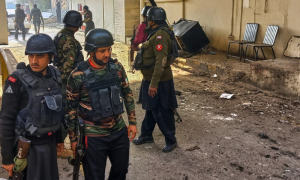ISLAMABAD: Pakistan’s military spokesperson, Lieutenant General Ahmed Sharif Chaudhry, on Wednesday said that the Pakistan Army has rescued more than 28,000 people from severely affected areas due to recent floods.
Speaking at a press conference in Islamabad, military spokesperson Director General of Inter-Services Public Relations (DG ISPR) said that the army has ramped up relief and rescue operations in flood-hit areas, following the directives of Chief of Army Staff (COAS) Field Marshal Syed Asim Munir.
The spokesperson said the troops are actively engaged in providing emergency assistance, ensuring the safety and well-being of impacted communities.
The DG ISPR stated that so far, the army has rescued more than 28,000 people from severely impacted areas. The army, he said, stands firmly with the people in their time of crisis.
Lieutenant General Chaudhry confirmed that during ongoing rescue missions, two Pakistan Army soldiers embraced martyrdom, while two others sustained injuries. These brave soldiers were operating in challenging terrain and severe weather conditions when the incident occurred.
He said beyond rescue efforts, the Army has been instrumental in restoring vital infrastructure. Three major bridges damaged by floods in Khyber Pakhtunkhwa and Gilgit have been repaired and reopened, facilitating the movement of relief supplies and personnel.
In Azad Kashmir, army battalions continue rehabilitation work, ensuring that essential road networks and supply routes remain accessible. Army engineers, collaborating closely with district administrations, have cleared numerous roads to reconnect isolated communities, he added.
In Kartarpur, a large-scale rescue operation is underway, with troops assisting stranded residents. To address urgent healthcare needs, the Pakistan Army has set up 29 medical camps across flood-affected areas, offering treatment and relief services to displaced families.
The Director-General of ISPR emphasised that while the Army remains focused on flood relief, it continues its counter-insurgency operations to prevent hostile elements from taking advantage of the current situation.
More rain expected
Chairman of the National Disaster Management Authority (NDMA) Lieutenant General Inam Haider , in his remarks, stated that Pakistan is currently in the eighth and penultimate spell of rainfall for 2025.
He added that heavy precipitation has been recorded in northern Punjab and occupied Kashmir, with over 300 mm of rain around Jammu and 600 mm near Sialkot. Water flow in the Indus River remains normal up to Kalabagh, Chashma, and Taunsa.
He said: “Rainfall exceeded 300 mm around Jammu, while areas near Sialkot experienced up to 600 mm. The floodwaters have now entered Pakistan’s territory through the Sutlej, Chenab, and Ravi rivers.”
“The Chenab River at Head Marala peaked at 700,000 cusecs, presently decreasing to approximately 550,000 cusecs due to reduced rainfall in north-eastern areas.”
“Flash floods and cloudbursts in occupied Kashmir have caused significant damage, submerging settlements and damaging infrastructure. Floodwaters from the Chenab, Ravi, and Sutlej rivers have now crossed into Pakistan’s borders,” the NDMA chairman said.
“At Head Khanki, a flood discharge of 1 million cusecs is causing increased pressure on Qadirabad in the coming days. Army engineers and PDMA Punjab are considering creating a breach to alleviate this pressure. Water levels between Khanki and Qadirabad are expected to remain constant over the next 24 hours,” he added.
The NDMA chief said, “a flood rally of 230,000 cusecs currently flows at the Ravi Jesar site, maintaining a pressure of 78,000 cusecs at Shahdara.”
This pressure is rising at Shahdara and Barki. Further rainfall is anticipated within 12 to 24 hours in Sialkot, Narowal, and Gujranwala, which will increase the strain on the rivers.”
He said, “Additionally, water has been released from Indian dams into the Sutlej, where heavy rainfall has also occurred. A significant flood of 250,000 cusecs is passing through Ganda Singh, comparable to the 250,000 to 300,000 cusecs flood of 2023, during which evacuation programmes were implemented.”
In response, Prime Minister Shehbaz Sharif has ordered federal ministers to immediately visit the hardest-hit districts to oversee and coordinate relief efforts on the ground. The Provincial Disaster Management Authority (PDMA) has also issued a high flood warning for the Ravi River at Jassar.
Rescue 1122 officials have reported that more than 32,500 people have been evacuated from vulnerable riverbank areas to safer locations as a precaution.
Adding to the crisis, Sialkot has recorded its heaviest rainfall in 49 years, shattering previous records. Meteorological authorities have warned that additional downpours are expected in the coming days across Punjab, heightening the risk of further flooding.

























